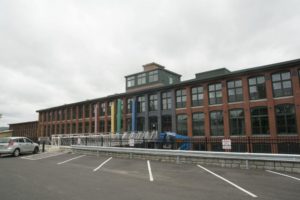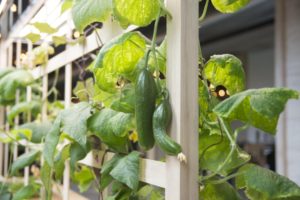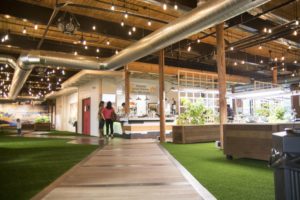Easthampton, Massachusetts, was a thriving mill town during the industrial revolution, but when manufacturing left the city, its industrial landscape remained. In recent years, Easthampton’s old mill buildings have been turned into loft-style apartments and art galleries. And now, an indoor park.

At the east end of the Pleasant Street mill district in Easthampton, there’s an imposing, red brick, factory building. But walk through the doors, into Mill 180 Park and you feel the crunch of artificial turf under your feet, you hear kids playing, you see natural light streaming through the windows.
The whole thing has visitors like Patrick Sullivan feeling a little surprised.
“You don’t expect to see this when you walk in a mill building,” Sullivan said.
His friend, Mark Plazcek, agreed.
“I didn’t know what to expect,” he said. “I was impressed when we came up here and walked in, it’s beautiful.”
The 14,000-square-foot space opened its doors in early September. In the middle, a cafe serves snacks and small plates along with beer and wine. Hydroponic planters throughout the room grow vegetables for the restaurant. Visitors can sit at picnic tables, stretch out or play lawn games.

“It’s a metaphoric outside park, so even though you know you’re inside there’s enough detail and features to make you slowly forget that,” said Michael Sundel, the owner and creator of the park.
Sundel lives in Virginia, where he runs a software company. But he’s always had a fascination with city parks. About two years ago, he had an idea to try to combine his interests to create a futuristic public space that would be usable year-round, regardless of weather.
“So I thought…obviously we don’t have thousands of acres, but if we use technology and good design, we can possibly put it in a building and it would be as useful as a large park,” he said.
Sundel became familiar with Easthampton when his daughter was going to boarding school nearby. He said he specifically chose the city for its perfect combination of empty industrial space and a population that has a history of supporting community projects and the arts.
“Even around here there are cities with huge empty mills and they don’t have the population to fill it. I think Easthampton is fortunate in that respect,” Sundel said.
Sundel and his wife have invested more than $2 million in the project so far. That has gone toward things like custom-designed furniture and high-end hydroponic gardening systems — everything designed to make the space feel bigger and more outdoorsy.
“We weren’t trying to rush it,” he said. “We were trying to get it right.”

Anyone can come spend the day at Mill 180 Park, use the free Wi-Fi or lie on the turf, and no one has to buy anything. There is the cafe, but Sundel isn’t counting on much revenue from food and drink sales.
“Running a restaurant is horrible, I’ll be blunt,” Sundel said, with a laugh.
That’s especially true in comparison to the highly efficient world of software that he’s used to, he said. And software is more what Sundel expects to keep the park open. He’s designing a program to manage his employees along with the indoor gardening equipment and the restaurant inventory. He hopes to turn a profit selling that software.
He’s also hoping the park’s hydroponic planters might inspire visitors to try indoor gardening, in which case, he could market some of that equipment.
But Sundel emphasized his main goal is to keep the space feeling like a public park and encouraging visitors to relax and interact. So far, that seems to be happening.
“I think it’s serving it’s purpose as an indoor park,” said visitor Samantha Battaglia. “There are people here lounging on the turf as though it’s a grassy lawn outside.”

Battaglia stopped by for a cup of coffee recently with her friend Caitlin Dwyer-Huppert, who said they’d likely be back.
“There’s potential for how we could use this, you know, coming and playing games to blow off steam,” Dwyer-Huppert said .
Michael Sundel said whether the business model will work or not is still an “open question.” But if it does, he hopes to bring more indoor parks to other cities around the U.S. in the near future.
